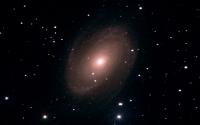Strongly Celestial Looking outward; looking backward in time... |
 |
||
Videos I have just started playing with computer modeling and simulation of celestial events. I will show here videos that I produce of my efforts. You can also find these on YouTube on the StronglyCelestial channel. |
||
Neptune the Wanderer Sometime in late May or early June I read an article about Neptune and its discovery. At the same time I was working with the remote iTelescope network of telescopes in New Mexico to take nightly pictures of various deep space objects. It then occurred to me that it would be interesting to attempt a time lapse video of Neptune moving across the night sky over the course of a couple of months. I picked one of the wide field telescopes from iTelescope, calculated where Neptune would be over the course of the next two month period, and centered the telescope on the midpoint of its path. I then took nightly images to capture Neptune as it moved across this ~1 degree patch of the sky. I used a combination if MaximDL (to help with frame-to-frame alignment) and PhotoShop (to adjust frame-to-frame exposure variations so they looked similar) to process ~50 images. Finally, I used a video editor to convert them into a 10 frame/sec video of the action. In the process of this, I discovered a little surprise about the images of Neptune, which I have featured at the end of this video! The music is a clip from the song "Harbinger" by Mike Oldfield on his album "Song of the Spheres". If possible, switch to 720p HD and expand to full screen to better see the action. Enjoy! |
||
Solar Timelapse I began to wonder on what time scale we might see changes in the sun. It rotates fairly slowly (25 days), so it would be difficult to depict that using pictures taken from the ground (unless you live in a location with little cloud cover most days). I decided to take a picture every 5 minutes one day and see what changed. Honestly...not much. Then I tried a picture per minute, and that time I spotted a prominence that formed over the course of 20-30 minutes. The next clear day I tried again, this time taking an image every 30 seconds. And I got lucky! This is a time lapse video of the sun taken on 3-14-2012. It was created from 360 individual photos taken through a Hydrogen-alpha (Ha) telescope, once every 30 seconds for 3 hours. By pure luck, there was a solar prominence event which occurred during the imaging process. This video captures - and zooms in on - that event. The prominence which formed over the course of about 60 minutes is at least 5 times the diameter of the Earth in size! This video has no sound...if anyone has a suggestion for a song to put to the video, please contact me and let me know! |
||
The Making of a Solar Time Lapse This video describes the steps I follow to create a time lapse video of the sun. It includes the final result of 5 hours of solar time (~600 individual images taken on May 11, 2012!) condensed into 10-15 seconds of video. Although it was not a wildly active day for the sun, there is an interesting section on the surface which I zoom in on to take a closer look. Unlike the video above (which looks at prominences), these images (and the resulting video) focus more on the surface detail of the sun itself. This video also has no sound...if anyone has a suggestion for a song to put to the video, please contact me and let me know! |
||
Stellar Impact What would happen if a small star wandered into our solar system? Imagine a star approaches our solar system tangentially and is caught by the Sun's gravity at a distance of 6 billion kilometers (about the distance of Pluto). The first part of this video explores the nature of gravity at work between two high mass objects even at this large distance. Watch as the clock ticks off the years and see how gravity brings them toward each other. The second part of the video shows the inevitable interaction between these stars and is provided thanks to simulation and video work made available by James Lombardi of Allegheny College. His website and other video work can be found it: |
||